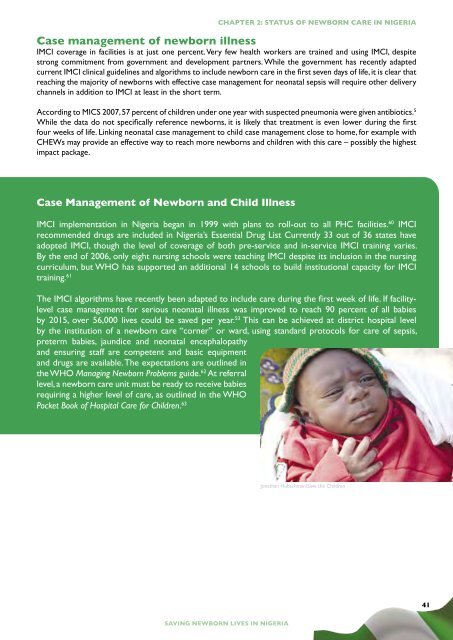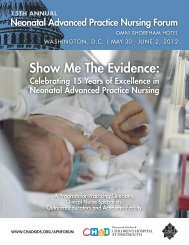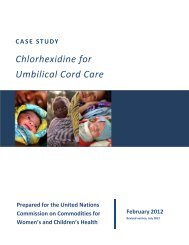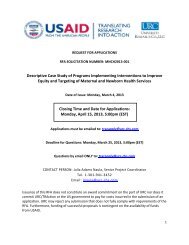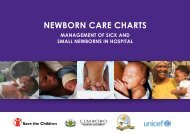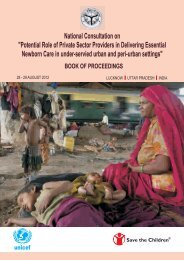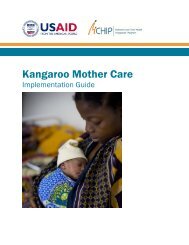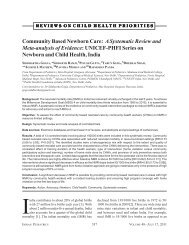CHAPTER 2: STATUS OF NEWBORN CARE IN NIGERIACare for the Sick <strong>Newborn</strong>Extra care for small babiesOnly an estimated 14 percent of Nigerian newborns are low birth weight, yet these babies account for themajority of newborn deaths. Kangaroo Mother Care (KMC) is a feasible and low cost approach for managing LBWbabies, has been shown to reduce mortality and serious morbidity in preterm babies and is being successfullyimplemented in several African countries.Kangaroo Mother Care in NigeriaExisting methods of caring for small babiesIncubators are widely used in developed countries for the care of verysmall and premature babies. However, because of their high cost, manyhospitals in Nigeria do not have incubators. Where incubators are available,often they do not work due to power cuts or missing parts. The numberof babies needing to use the incubator often exceeds the number ofavailable incubators. In addition, the prolonged stay in hospital associatedwith incubator care is often very costly for most families, and contributesto overcrowding of the already small space in neonatal units.Alternative method: Kangaroo Mother CareAs soon as the small baby is stable and has no complications, KangarooMother Care (KMC) is initiated. KMC involves provision of warmththrough skin-to-skin contact of the mother and baby’s bodies. The babyis undressed except for a cap on the head, nappy and socks, and is placedupright between the mother’s breasts with its head turned to one side.The baby is then tied to the mother’s chest with a cloth and covered withJonathan Hubschman/Save the Childrenthe mother’s clothes. If the mother is not available, the father or any adultcan provide skin-to-skin care. Once the baby is gaining weight and caregivers have learned to provideKMC, they are discharged from the hospital and are seen for follow up clinic visits.Advantages of Kangaroo Mother CareKMC is safe, cheap and affordable for most mothers. KMC is effective for keeping the baby warm andalso enables early breastfeeding, protection from infections, early stimulation, love and bonding of theparents to the newborn baby. There is no special ward required and KMC can be practiced within theexisting postnatal ward. KMC reduces the amount of hospital space required to manage newborns, andoften reduces the average length of stay in the hospital.Kangaroo Mother Care can save lives in NigeriaKMC was first introduced to Nigeria in the late 1990s through a resident paediatrician at the Universityof Lagos Teaching Hospital. Following a month-long training in Bogotá, Colombia, the first study on skintoskin care for Nigerian newborns was conducted in 2001. The results of this study were presentedat the 2002 Paediatric Association of Nigeria (PAN) conference and published in the Nigeria Journalof Paediatrics. A training workshop was held with doctors and nurses from sixteen teaching hospitalsacross the country. In 2007, ACCESS supported the introduction of KMC in two general hospitals inKano and Zamfara states. As part of the process, ACCESS worked with the FMOH to adapt a KMCtraining manual, which could be used by health institutions across the country to train staff on KMC.KMC practice has continued at various levels but it has not been systematically rolled out since therehas not been a <strong>plan</strong> to expand services beyond the existing KMC centres. No national KMC policy,service guidelines or routine data collection system exists. KMC was included in the Infant and YoungChild Feeding Guidelines, the National Child Health Policy, and Key Strategies for CIMCI, but it wasoverlooked in the IMNCH strategy. This is despite the fact that reaching all preterm babies in Nigeriawith KMC alone by 2015 would save over 19,000 lives per year. 5340SAVING NEWBORN LIVES IN NIGERIA
CHAPTER 2: STATUS OF NEWBORN CARE IN NIGERIACase management of newborn illnessIMCI coverage in facilities is at just one percent. Very few health workers are trained and using IMCI, despitestrong commitment from government and development partners. While the government has recently adaptedcurrent IMCI clinical guidelines and algorithms to include newborn care in the first seven days of life, it is clear thatreaching the majority of newborns with effective case management for neonatal sepsis will require other deliverychannels in addition to IMCI at least in the short term.According to MICS 2007, 57 percent of children under one year with suspected pneumonia were given antibiotics. 5While the data do not specifically reference newborns, it is likely that treatment is even lower during the firstfour weeks of life. Linking neonatal case management to child case management close to home, for example withCHEWs may provide an effective way to reach more newborns and children with this care – possibly the highestimpact package.Case Management of <strong>Newborn</strong> and Child IllnessIMCI implementation in Nigeria began in 1999 with <strong>plan</strong>s to roll-out to all PHC facilities. 60 IMCIrecommended drugs are included in Nigeria’s Essential Drug List Currently 33 out of 36 states haveadopted IMCI, though the level of coverage of both pre-service and in-service IMCI training varies.By the end of 2006, only eight nursing schools were teaching IMCI despite its inclusion in the nursingcurriculum, but WHO has supported an additional 14 schools to build institutional capacity for IMCItraining. 61The IMCI algorithms have recently been adapted to include care during the first week of life. If facilitylevelcase management for serious neonatal illness was improved to reach 90 percent of all babiesby 2015, over 56,000 lives could be saved per year. 53 This can be achieved at district hospital levelby the institution of a newborn care “corner” or ward, using standard protocols for care of sepsis,preterm babies, jaundice and neonatal encephalopathyand ensuring staff are competent and basic equipmentand drugs are available. The expectations are outlined inthe WHO Managing <strong>Newborn</strong> Problems guide. 62 At referrallevel, a newborn care unit must be ready to receive babiesrequiring a higher level of care, as outlined in the WHOPocket Book of Hospital Care for Children. 63Jonathan Hubschman/Save the Children41SAVING NEWBORN LIVES IN NIGERIA


